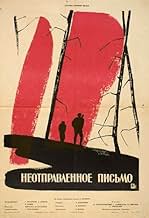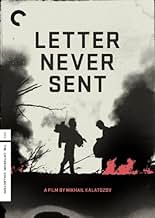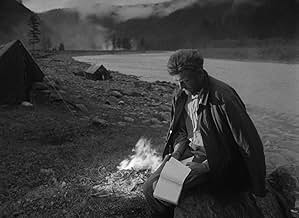IMDb-BEWERTUNG
7,8/10
4639
IHRE BEWERTUNG
Vier Geologen suchen in der Wildnis Sibiriens nach Diamanten.Vier Geologen suchen in der Wildnis Sibiriens nach Diamanten.Vier Geologen suchen in der Wildnis Sibiriens nach Diamanten.
- Auszeichnungen
- 1 Nominierung insgesamt
Innokentiy Smoktunovskiy
- Konstantin Sabinin
- (as I. Smoktunovskiy)
Tatyana Samoylova
- Tanya
- (as T. Samoylova)
Vasiliy Livanov
- Andrey
- (as V. Livanov)
Evgeniy Urbanskiy
- Sergey Stepanovich
- (as Ye. Urbanskiy)
Galina Kozhakina
- Vera
- (as G. Kozhakina)
Empfohlene Bewertungen
This robust survival adventure follows a team of Soviet geologists stranded in the wilderness of Siberia after a forest fire severs their communication link with civilization. The opening dedication to Socialist heroes everywhere and the noble sacrifices made by each character carry the story dangerously close to propaganda, but the intensity of their ordeal (through smoke and fire, over snow and ice, across mountains and tundra) thankfully overwhelms the political simplicity of the script. Unfortunately, it also overwhelms the initial hints of tension between each of the four characters (three male, one female) after the struggle to survive becomes paramount. The sense of isolation and exposure is numbing; the film was directed with a strong sense of visual drama (including more than one knockout montage), showing everything an audience would ever want to know about being lost in Siberia.
A quite ridiculous film about diamond hunters in Siberia by the extraordinary director/cinematographer team of "I Am Cuba" and "The Cranes Are Flying." Needless say, the camerawork in the bizarrely surreal and barren Siberian locations is UNBELIEVABLE (the continuous takes are longer than any other film in history except for "I Am Cuba") but the film itself is too directly tied to dramatic 'adventure story' conventions to transcend into pure poetry like "Cranes" and "Cuba." There is a spectacular scene shot with the main actors amidst a raging forest fire and another one shot during an ice-storm. Most definitely worth transferring to DVD (there isn't a true film fan that wouldn't be flabergasted by the cinematography) but not by the same ones (Hen's Tooth) who did such a mediocre job on the transfer of "I Am Cuba."
9Fpi
This is a totally excellent man vs. nature drama. An outstandingly dramatic soundtrack is coupled with some of the most powerful and unique visuals I've ever seen. If you thought Tarkovsky was a one-shot in the Soviet Union when it came to beautiful yet haunting images, you'll definitely think again after this movie. The characters and the story are perhaps not too well developed, but this somehow adds to the sense of not being totally in control, which is important here. It's nothing short of a tragedy that this movie is totally unknown; it would probably have been a candidate of reaching IMDb's top 50 if it were. Those looking for unknown classics should hunt this one down at all costs.
Loss, purpose, and redemption, all in this harrowing adventure and visual tour-de-force by usual suspects Kalatozov/ Urusevsky.
An expedition of diamond hunters is dropped in the Siberian plateau with the mission of discovering a rumoured diamond vein. In the course of the movie diamonds acquire a further symbolic aspect as the purpose in life. As the expedition is befallen by a raging fire and forced to make a hazardous escape through burning logs, saving the map which points to the location of the much sought-after diamonds becomes a struggle to preserve purpose and meaning in a world that defies it. As the surviving members of the expedition stagger through the charred landscape, amidst billows of smoke and torrents of rain, nothing there to answer their pleas and curses but the echo of their voices, the world seems indifferent to their plight.
The star of the movie however is Urusevsky's cinematography. Kalatozov fails to harness his tremendous visual talent as he did in THE CRANES ARE FLYING, certain scenes flailing for attention but lacking the dramatic pull to justify them, but still someone who likes movies for their pictorial quality, for the endless possibilities of capturing images with a photographic lens and moving inside a thridimensional canvas; such a person will be left in awe and admiration of what Urusevsky achieves. His rapid tracking shots through branches of trees, as though the nature conspires to ensnare the protagonists, the amazing clarity of the closeups, the maize of hand-held shots thrusting the viewer right there in the middle of the action, the beautiful dutch angles transforming the geography of the landscape into something that can only exist for and by the camera.
Although the plot has its heart in the right place, much like its predecessor, it suffers from being too overwrought and from lapsing into moments of melodrama. Plot threads that are emphasized early on, like Sergei's unrequisite love and the growing tension with Tanya, are never really resolved and come to a screeching halt when the fire erupts. Traditional Soviet values, like the leader's dream of a Diamond City and the portrayal of civilization as a collective good, don't chime with my sensibilities. The score is often jarring and obtrusive but that's 50's cinema for you.
Overall this is a visually marvellous film aimed at the cinephiles who can appreciate such things.
An expedition of diamond hunters is dropped in the Siberian plateau with the mission of discovering a rumoured diamond vein. In the course of the movie diamonds acquire a further symbolic aspect as the purpose in life. As the expedition is befallen by a raging fire and forced to make a hazardous escape through burning logs, saving the map which points to the location of the much sought-after diamonds becomes a struggle to preserve purpose and meaning in a world that defies it. As the surviving members of the expedition stagger through the charred landscape, amidst billows of smoke and torrents of rain, nothing there to answer their pleas and curses but the echo of their voices, the world seems indifferent to their plight.
The star of the movie however is Urusevsky's cinematography. Kalatozov fails to harness his tremendous visual talent as he did in THE CRANES ARE FLYING, certain scenes flailing for attention but lacking the dramatic pull to justify them, but still someone who likes movies for their pictorial quality, for the endless possibilities of capturing images with a photographic lens and moving inside a thridimensional canvas; such a person will be left in awe and admiration of what Urusevsky achieves. His rapid tracking shots through branches of trees, as though the nature conspires to ensnare the protagonists, the amazing clarity of the closeups, the maize of hand-held shots thrusting the viewer right there in the middle of the action, the beautiful dutch angles transforming the geography of the landscape into something that can only exist for and by the camera.
Although the plot has its heart in the right place, much like its predecessor, it suffers from being too overwrought and from lapsing into moments of melodrama. Plot threads that are emphasized early on, like Sergei's unrequisite love and the growing tension with Tanya, are never really resolved and come to a screeching halt when the fire erupts. Traditional Soviet values, like the leader's dream of a Diamond City and the portrayal of civilization as a collective good, don't chime with my sensibilities. The score is often jarring and obtrusive but that's 50's cinema for you.
Overall this is a visually marvellous film aimed at the cinephiles who can appreciate such things.
Saw this at Tribeca Film Festival in Spring 2007, and was absolutely floored. I walked out of the theater afterword amazed at what I'd seen and thrilled that such an amazing film existed and had been maintained by a tiny number of appreciators in such excellent quality for so long.
The story is not the strong point of the movie. Rather, as with Terence Malick films, the story is just a starting point for the film, which is another beast entirely. What shines and carries the film from scene to scene is the cinematography. I didn't know if this was happened elsewhere at the time, but I didn't expect to see hand-held camera work in a 1959 Russian film, let alone the kind of early spinning, impossibly-filmed shot that appears early in the film. Later, there is a sequence that makes me long to know how they created the opportunity to film in such conditions.
If you've read this far, you must track down this movie. My understanding is that Francis Coppola has a California archive maintain the only copy in the Americas, and that it's usually shown just one a year.
The story is not the strong point of the movie. Rather, as with Terence Malick films, the story is just a starting point for the film, which is another beast entirely. What shines and carries the film from scene to scene is the cinematography. I didn't know if this was happened elsewhere at the time, but I didn't expect to see hand-held camera work in a 1959 Russian film, let alone the kind of early spinning, impossibly-filmed shot that appears early in the film. Later, there is a sequence that makes me long to know how they created the opportunity to film in such conditions.
If you've read this far, you must track down this movie. My understanding is that Francis Coppola has a California archive maintain the only copy in the Americas, and that it's usually shown just one a year.
Wusstest du schon
- WissenswertesIn 1995 the film was restored by and shown in United States upon the financial support from Francis Coppola.
- Zitate
Andrey: Sergei, you've fallen in love with a girl who loves someone else, and that man loves her. From the moral standpoint it's wrong.
Sergey Stepanovich: I don't give a damn about your bookish morale. I'm in love.
Andrey: That's an egoist speaking.
- VerbindungenFeatured in Fejezetek a film történetéböl: A szovjet film 1953-1970 (1990)
Top-Auswahl
Melde dich zum Bewerten an und greife auf die Watchlist für personalisierte Empfehlungen zu.
- How long is Letter Never Sent?Powered by Alexa
Details
- Erscheinungsdatum
- Herkunftsland
- Offizieller Standort
- Sprache
- Auch bekannt als
- Letter Never Sent
- Drehorte
- Produktionsfirma
- Weitere beteiligte Unternehmen bei IMDbPro anzeigen
- Laufzeit1 Stunde 36 Minuten
- Farbe
- Sound-Mix
- Seitenverhältnis
- 1.37 : 1
Zu dieser Seite beitragen
Bearbeitung vorschlagen oder fehlenden Inhalt hinzufügen

Oberste Lücke
By what name was Ein Brief, der nicht abging (1960) officially released in India in English?
Antwort
























